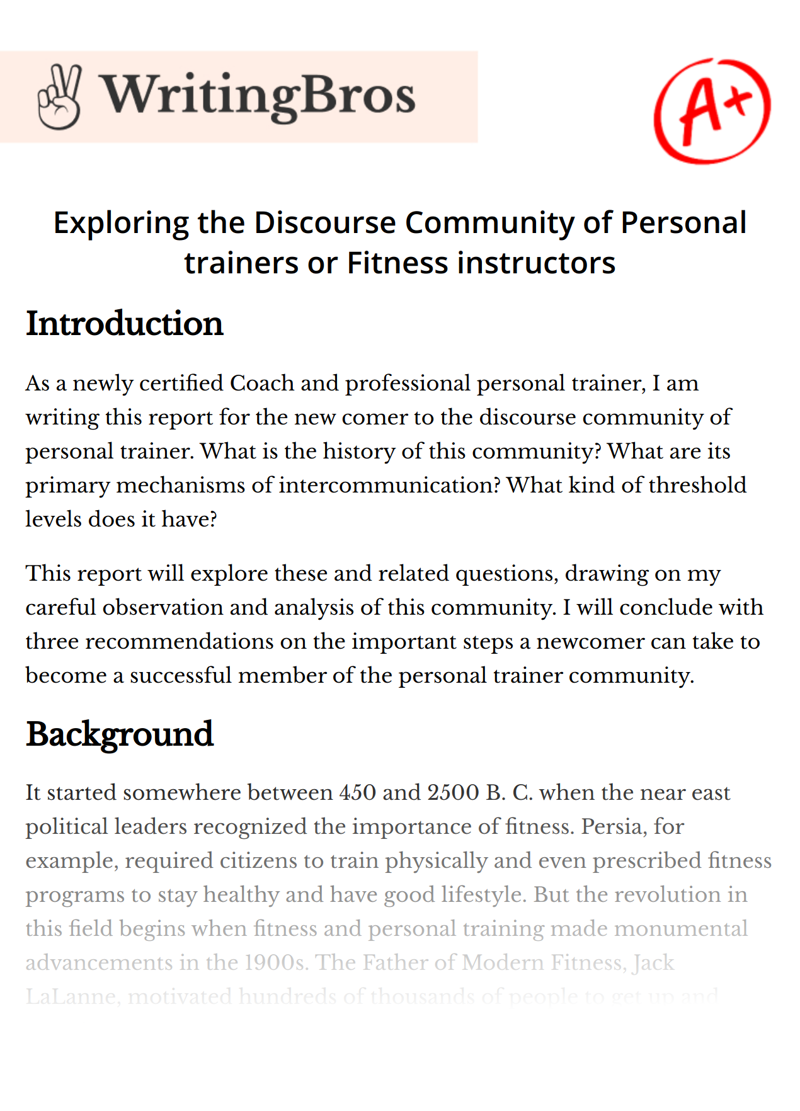Exploring the Discourse Community of Personal trainers or Fitness instructors

Table of contents
Introduction
As a newly certified Coach and professional personal trainer, I am writing this report for the new comer to the discourse community of personal trainer. What is the history of this community? What are its primary mechanisms of intercommunication? What kind of threshold levels does it have?
This report will explore these and related questions, drawing on my careful observation and analysis of this community. I will conclude with three recommendations on the important steps a newcomer can take to become a successful member of the personal trainer community.
Background
It started somewhere between 450 and 2500 B. C. when the near east political leaders recognized the importance of fitness. Persia, for example, required citizens to train physically and even prescribed fitness programs to stay healthy and have good lifestyle. But the revolution in this field begins when fitness and personal training made monumental advancements in the 1900s. The Father of Modern Fitness, Jack LaLanne, motivated hundreds of thousands of people to get up and exercise. Through his television show as a fitness instructor and at his bally gyms he inspired people to use exercise and lifestyle choices as preventative medicine.
Research and Analysis
Fitness instructors as a group share many of the characteristics that make them a discourse community, as per the research of John Swales in his article, “Six Characteristics of Discourse Communities” (COMM202—Communications II, 2017).
In this section, I will explore how the fitness instructor community demonstrates three of these characteristics.
Firstly, according to Swales, “a discourse community has a broadly agreed-upon set of common public goals” (COMM202—Communications II, 2017, para. 1). This is certainly true of the community of personal; trainers. One of the primary goals in this community is to create personalised training plans for clients, helps them to reach their fitness goals, improve athletic skills as well as their lifestyle, motivate clients by setting goals, providing feedback and accountability to clients, educate their clients in many other aspects of wellness besides exercise, including general health and nutrition guidelines.
Moreover, one of the main goal of this community is, if a trainer suspects that one of their clients has a medical condition that could prevent the client from safe participation in an exercise or fitness class, they must refer the client to the proper health professional for prior clearance. So this are some basics common goals which are shared among fitness instructors community.
Secondly, “a discourse community has mechanisms of intercommunication among their members” (COMM202—Communications II, 2017, para. 2). The fitness instructor community that I belong has some mechanisms of intercommunication among their members such as we send and reply emails to each other, stay connected with phone calls, text messages, social media handles, fitness apps, meetings and gathering before any program or workshop. Furthermore, in meetings or before starting a workshop we say our slang to get boost up “Kar Har Maidan Fateh” which means win every battlefield. So, this are some ways by which we stay connected with each other.
Thirdly, swales also notes that “a discourse community has a threshold level of members with a suitable degree of relevant content and discoursal expertise” (COMM202—Communications II, 2017, para. 6).
The Personal trainer community with which I am associated features a good ratio of beginners to experts. James Patterson has worked as a fitness instructors for about 25 years and now has his own gym in Brampton. In an interview, he spoke about various opportunity the members of this community will get such as starting from level 1 fitness instructor where they will work under the experience instructors to level 2 where they will provide instructions to clients as well as to new comers and at last level 3 in which you will become the head of all instructors and take care about new programs or workshop and once you get expert in this you can now open your own gym. (J. Patterson, personal communication, January 24, 2019).
Conclusions and Recommendations
As shown above, the fitness instructor community has its own set of unique goals, language, and learning journey. Based on my observations, research and experience, I would suggest the following three steps for becoming an effective personal trainer.
1. Acquire the requisite education and certification to become a professional personal trainer in order to provide the full range of support necessary to the clients in the gym.
2. Commit to the rules and regulations of personal trainer while working with clients such as personal trainer.
3. Seek mentorship from existing members of this community, particularly those who joined not too long ago and still remember what it’s like to be a newcomer. Learn from their experiences, what they enjoy about it, what has helped them most.
As globalization is increasing people are also people becoming lazier day by day, which resulting in sedentary behaviour, obesity, bad lifestyle, so they will need a good fitness instructor to change this things and I know you will do a great job and progress from novice to expert within this discourse community.
Cite this Essay
To export a reference to this article please select a referencing style below

